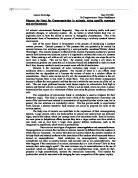Comparing the Processes of Osmoregulation and Nitrogenous Excretion Between Insects and Mammals. Due to the unforgiving nature of the natural environment
Comparing the Processes of Osmoregulation and Nitrogenous Excretion Between Insects and Mammals.
Due to the unforgiving nature of the natural environment, animals have had to develop ways to survive in many different climatic conditions. These evolutionary transformations have given rise to a variety of ways in which animals attempt to maintain homeostasis. Two major means of achieving this is through osmoregulation and nitrogenous excretion.
A condition that can be problematic for terrestrial mammals and insects is desiccation. This is the drying process where moisture is removed from an organism. Desiccation can be particularly bad when the environmental temperature is high and there is little moisture in the air. This is because ‘dryer air leads to a greater saturation deficit, which is where there is a difference in the vapour pressure (the pressure applied by a vapour, whilst in equilibrium with the liquid or solid form of the same substance - increases with temperature) of water in the air over a free water surface and the vapour pressure in air’ (Eckert, 2002). Desiccation tends to be worse for smaller animals with a high surface area to volume ratio. As animals in a terrestrial environment are contained by air, then unless there is relatively high air humidity, animals with a permeable epithelium are subject to dehydration. Another accelerant of ‘drying out’ is the movement of air. As moisture evaporates off a vapour limited system (e.g. skin of most mammals), the movement of air (less dense) takes away the evaporated water molecules. This in turn allows for more water molecules to evaporate off, leading to ‘drying out’. On a membrane limited system (insect cuticle) the outer layer of the animal is waterproof; therefore evaporation under ‘normal’ conditions does not occur. If these animals were not water permeable then there would also be a limited capacity for oxygen (O2) and carbon dioxide (CO2) to pass through the epithelium. As a result it is because of the respiratory epithelia that dehydration mainly occurs.
Through evolutionary changes, insects have become terrestrial animals. One aspect of insect physiology that highlights these changes is the system of oxygen delivery to the body. The insect tracheal system benefits from the fact that O2 and CO2 diffuse approximately 10000 times faster in air than in water, blood or tissue. It is made up of an arrangement of air filled tubes that breach the body surface and travel directly into the cells. It is therefore much quicker than mammalian respiration/circulation. Throughout the tracheae are air sacs which store air, and as a result possibly help with buoyancy and balance. The openings to the tubes, known as spiracles, can be adjusted to manipulate the air flow through the tracheae, manage the loss of water and to keep out dust and other harmful particles. These spiracles manage the aforementioned water loss by opening and closing at regular intervals. This operation of the spiracles may develop into what is known as cyclic respiration (e.g. locusta). As there are often long breaks between the openings of the spiracles, CO2 often accumulates to a dangerous level. As such, this triggers a response in the insect that cause the spiracles to open. In some bigger insects the air sacs used for storage, through muscular contraction, can be used to forcibly expel air through the tracheae which creates a unidirectional air flow. This in turn allows for a better delivery of O2 throughout the insects body. Aquatic insects, however, have a closed tracheal system in which the openings to the spiracles are covered by an extremely thin cuticle sheet. This layer allows O2 to diffuse through from the surrounding water.







